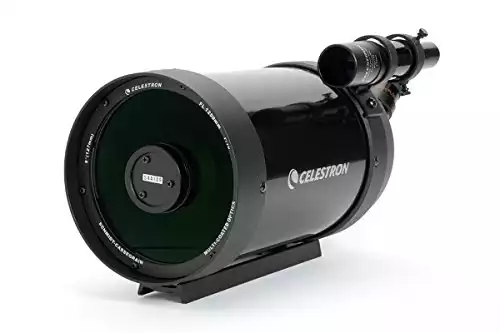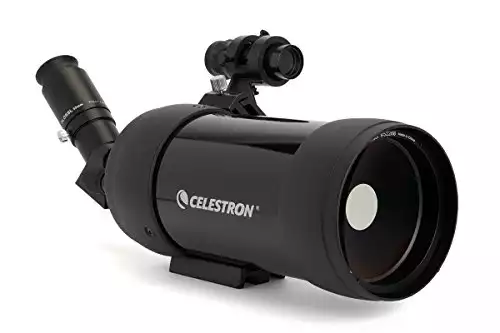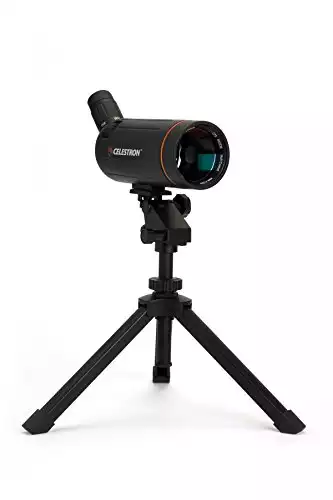There are many advantages to using a spotting scope over a telescope for astronomy – easier to use with fewer accessories involved, versatile for daytime and night sky use, and tend to be cheaper.
In this article, we have researched the best spotting scope for astronomy for different budgets and needs and outlined the pros and cons of using them versus telescopes, binoculars, and monoculars.
See the quick links below or read on for more detail.
|
Make & Model:
Celestron C5
|
Make & Model:
Celestron C90 Mak
|
Make & Model:
Celestron C70 Mini Mak
|
|
Aperture:
5-inch (127mm)
|
Aperture:
3.5-inch (90mm)
|
Aperture:
2.8-inch (70mm)
|
|
Magnification:
50x
|
Magnification:
39x
|
Magnification:
25-75x
|
|
Focal length:
49-inch (1250mm)
|
Focal length:
49-inch (1250mm)
|
Focal length:
30-inch (750mm)
|
|
Weight:
6lb (2.7kg)
|
Weight:
4.6lb (2kg)
|
Weight:
2.3lb (1kg)
|
|
Focal ratio:
F/10
|
Focal ratio:
F/14
|
Focal ratio:
F/11
|
|
Optical Design:
Schmidt-Cassegrain
|
Optical Design:
Maksutov-Cassegrain
|
Optical Design:
Maksutov-Cassegrain
|
Best Spotting Scopes for Astronomy
Celestron C5 Spotting Scope
Most Powerful Spotting Scope for Astronomy
The Celestron C5 Spotting Scope is the best spotting scope for astronomy and astrophotography.
In fact, we can let you into a secret – it is actually an astronomical telescope packaged as a spotting scope: It is the same telescope tube as comes with the popular Celestron NexStar 5SE just in black instead of orange, without the GOTO mount/tripod, and with different accessories.
Therefore it stands to reason that this is a great spotting scope that will give you great stargazing options, as well as be versatile enough to use in the daytime for terrestrial use like birding, ocean-watching, and hunting and shooting.
The C5 uses a Schmidt-Cassegrain catadioptric optical design. If you don’t know what this means it doesn’t matter, it just means that it houses a combination of lenses and mirrors that enables it to have a longer focal length and provide a greater image quality whilst staying compact in size and low in weight. In contrast, most regular spotting scopes will use just lenses.
The key specification with any device for astronomy is the aperture. This is the measurement of the diameter of the lens, and the bigger this is, the brighter and clearer the night sky views you get will be. With this spotting scope you get a 5-inch aperture, which would make it a good mid-sized telescope let alone a great spotting scope for astronomy.
Since it is in essence an astronomical telescope, it can be used with other astronomical eyepieces and filters to give you the options you would have with a telescope.
The marketing blurb for this scope boasts that it has been used “by NASA for many space shuttle missions” as it was the first Celestron telescope to go into space (see here) and others have followed since.
It doesn’t come with a tripod as standard but can be mounted upon any camera tripod that can carry over 6 lbs. This means you can use whatever tripod you have, or you can get a full-on telescope mount – maybe with GOTO technology – to take your astronomy and astrophotography to the next level.
It can be used to photograph space and objects in the night sky. And not just with a smartphone like most other spotting scopes, you can also attach a DSLR/mirrorless camera (using a T-ring and T-adapter) and it effectively becomes a 1250mm F/10 telephoto lens.
Overall, this is the best spotting scope for astronomy. Some might call it overkill to have 5-inches of aperture, but it really gives you the option to go out and view Jupiter or Saturn’s rings when the conditions are right and use it like a regular telescope whilst having the versatility of being a spotting scope for terrestrial use.
Pros
- Large aperture for great and clear views of objects in the night sky like the moon, the planets, and even other galaxies.
- Can be used with different astronomical eyepieces and filters, just as a telescope would.
- Great for astrophotography.
- Waterproof and hardy.
- Comes with a secure carry case for portability.
Cons
- Given its high-quality build, it’s naturally fairly expensive compared to many regular spotting scopes.
- It doesn’t come with a tripod, so you’ll need to own or buy a separate one.
- It’s larger and heavier than most other spotting scopes.
Key specifications
- Optical Design: Catadioptric (Schmidt-Cassegrain)
- Aperture: 5-inch (127mm)
- Magnification: 50x (with included eyepiece, can be changed with different eyepieces)
- Focal Length: 49-inch (1250mm)
- Focal Ratio: F/10
- Eye Relief: 22mm (with included eyepiece)
- Weight: 6lb (2.7kg)
- Included Accessories: 25mm eyepiece, 45 degree diagonal, finderscope, carry case
5-inch Aperture Schmidt-Cassegrain Spotting Scope
- Large aperture for great and clear views of objects in the night sky like the moon, the planets, and even other galaxies
- Can be used with different astronomical eyepieces and filters, just as a telescope would
- Waterproof, hardy, and comes with a secure carry case for portability
- More expensive than regular spotting scopes
- Doesn't come with a tripod
- Fairly large and heavy
Celestron C90 Mak Spotting Scope
Best Budget Spotting Scope for Astronomy
The Celestron C90 Spotting Scope is similar to the C5 above in that it is in many ways a telescope masquerading as a spotting scope, and so naturally delivers for stargazing.
The “90” in the name refers to the 90mm (3.5-inch) aperture. This is smaller than the C5 above, where the “5” refers to the aperture in inches (127mm).
So, if this has a lower aperture than the C5, why consider it?
In short, it’s substantially cheaper, it’s notably lighter and smaller, and it comes with its own backpack.
These are some pretty significant positives for many, especially if you want to carry it around and mostly use it away from home.
The magnification is 39X with the included eyepiece, although, like the C5 above and the Mini-Mak below, the eyepieces are interchangeable.
Also, like the C5, it can have a DSLR/mirrorless camera attached directly for astrophotography using a T-ring and T-adapter, or you can use a simple smartphone adapter.
Pros
- 90mm catadioptric optics effectively make this a mini-telescope and it can excel for viewing objects in the night sky.
- It can be used with different telescope eyepieces and filters for astronomy.
- It is light and compact and comes with its own backpack for easy storage and travel.
- You can attach your camera or smartphone to take astrophotography images, effectively turning it into a 1250mm F/14 telephoto lens.
- Can be used on any tripod for a camera or telescope.
- Cheaper than the C5 spotting scope (above).
Cons
- Aperture is smaller than that of the C5 and so views will be less impressive.
- Doesn’t come with a tripod.
Overall, this is a great spotting scope and is far better for astronomy than most regular spotting scopes. It doesn’t have the viewing capacity of the larger C5 above, but it is much cheaper and more portable.
Key specifications
- Optical Design: Catadioptric (Maksutov-Cassegrain)
- Aperture: 3.5-inch (90mm)
- Magnification: 39x (with included eyepiece, can be changed with different eyepieces)
- Focal Length: 49-inch (1250mm)
- Focal Ratio: F/14
- Eye Relief: 20mm (with included eyepiece)
- Weight: 4.6lb (2kg)
- Included Accessories: Backpack, 32 mm eyepiece, diagonal, finderscope.
3.5-inch aperture Maksutov-Cassegrain Spotting Scope
- 90mm aperture effectively makes this a mini-telescope that excels for viewing objects in the night sky and can be used with astronomy telescope eyepieces and filters
- Light and compact and comes with its own backpack for easy storage and travel
- Can attach your camera or smartphone to take astrophotography images, effectively turning it into a 1250mm telephoto lens
- Aperture is smaller than that of the Celestron C5 and so views will be less impressive
- Doesn't come with a tripod
Celestron C70 Mini Mak Spotting Scope
Best Portable Spotting Scope for Astronomy
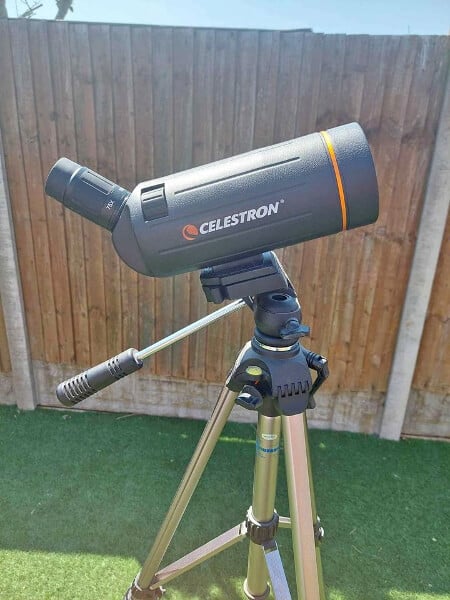
The third Celestron spotting scope that we are recommending is the C70 Mini Mak.
Like the two above, it is built on existing telescope technology that Celestron has repurposed into a spotting scope for great flexibility.
It has the lowest aperture (70mm) of the three and so will not provide views that are as good, but it has many positives.
First, it is very small and light and is just 11 inches long, so excels as an ultra-portable option that is great for travel. It comes with a mini tabletop tripod included. And, it is the cheapest.
It has a built-in zoom eyepiece so that you can adjust it from 25x up to 75x. This is interchangeable with other eyepieces using an adapter that comes included.
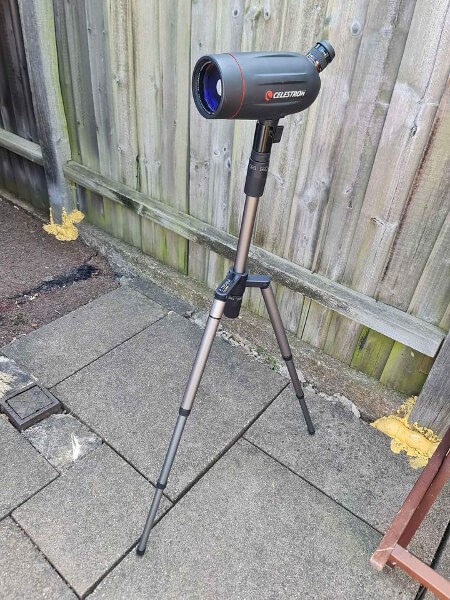
Pros
- Ultra-light at just 1kg.
- Small and compact for easy travel.
- Built-in zoom eyepiece allowing up to 75x magnification (and can be used with other eyepieces).
- Mini-tripod comes included.
- 70mm aperture for good night sky views.
- Cheaper than the two models recommended above.
Cons
- Lower aperture than the other Celestron spotting scopes above and so the image quality will not be as high quality.
- Too small to be able to support a DSLR/mirrorless camera for photography, but can be used with a smartphone when using an adapter.
- You’ll need to be somewhere with a table or similar height object to rest it on to use with the included tripod (although it can also be used with a regular full-height tripod).
Overall, this is a great option if you want something ultra-portable to take out on hikes or trips. It’s a step above a regular spotting scope (or a high-quality monocular) and is great value for the price.
Key specifications
- Optical Design: Catadioptric (Maksutov-Cassegrain)
- Aperture: 2.8-inch (70mm)
- Magnification: 25-75x (with built-in zoom eyepiece)
- Focal Length: 30-inch (750mm)
- Focal Ratio: F/11
- Eye Relief: 22mm (with built-in eyepiece)
- Weight: 2.3lb (1kg)
- Included Accessories: Table-top tripod, interchangeable eyepiece adapter, soft-side carry case.
Compact spotting scope with 25-75x zoom magnification and 70mm aperture lenses
- Maksutov-Cassegrain optical design with 70mm aperture multi-coated optics
- Built-in 25-75x magnification zoom eyepiece
- Includes tabletop tripod and soft carrying case
- Brings portability and versatility to a new level
- Applicable for both terrestrial (land) and astronomical use
- Lower aperture than the Celestron C5 and C90 spotting scopes
- Too small to be able to support a DSLR/mirrorless camera but can be used with a smartphone
- Needs a tabletop to use with the included tripod (although it can also be used with a regular full-height tripod)
Celestron Spotting Scopes for Stargazing
Celestron is probably the most popular manufacturer of astronomy gear in the world and their spotting scopes are excellent.
The three Celestron spotting scopes recommended above are from their catadioptric range – this means that they are basically mini-telescopes and so are the best for astronomy whilst also being able to be used in the daytime like regular spotting scopes.
In addition to being able to fit other astronomy eyepieces, they can also fit star diagonals so that the eyepiece viewing angle can be better suited to looking up at the night sky. This bypasses one of the major problems with regular spotting scopes for astronomy use.
This video gives a brief overview of this range of spotting scopes:
There are several other Celestron spotting scopes that are more like traditional models intended for terrestrial use, but they can still definitely be used for stargazing.
Like the catadioptric range, the below Celestron spotting scope ranges can also be used with interchangeable astronomy telescope eyepieces and filters:
- Celestron Hummingbird ED Spotting Scopes
- Celestron Trailseeker Spotting Scopes
- Celestron Regal ED Spotting Scopes
You can check here with regards to eyepiece compatibility and Celestron spotting scope models.
There are other ranges, like the Ultima range, but these have in-built zoom eyepieces which cannot be interchanged. This is not to say that they cannot be used for astronomy though as they certainly can.
What to look for in a Spotting Scope for Astronomy
The key things to look for in a spotting scope for astronomy are defined by a number of key specifications.
Let’s look at each of these now and explain what they mean to help you identify what you need.
Optical Design/Type
Essentially, spotting scopes are either refractors – tubes with lenses inside – or catadioptrics – tubes with lenses and mirrors inside.
The mirrors inside catadioptrics (Schmidt-Cassegrain or Maksutov-Cassegrain) allow the focal length to be longer without the tube being longer and weighing more.
The majority of the best spotting scopes for astronomy recommended above are catadioptrics, but the majority of regular spotting scopes are refractors.
Aperture (Objective Lens Diameter)
This is a key measurement to pay attention to – the same with a telescope or any optical device. The higher the aperture, the better the views will be of the night sky.
Magnification
This measures how zoomed into the object you are viewing will be. It is not static for scopes with interchangeable eyepieces as changing these changes the magnification.
Higher magnification is not always better though – if the aperture is not large enough to provide clear views then high magnification will just multiply the flaws in what you see.
Focal Length
This is the distance between the lens (or mirror) of the scope and the eyepiece.
Higher focal lengths are better for viewing the moon and planets as your view is narrower, but lower focal lengths are better for viewing wider expanses of the sky and deep-sky objects.
Focal Ratio
This is the measure of how fast the scope gathers light. This is mostly important for astrophotography, where a faster focal ratio (indicated by a lower f-number) is better for capturing images.
Eye Relief
This is simply the measurement of how far away your eye needs to be from the eyepiece when viewing. If this is too short then it can be less comfortable and it’s important for glasses wearers who need to ensure this is large enough for them.
Weight
Obviously, the lighter it is the easier it will be to handle and take out.
Prism Glass Type
Different models will boast about glass types like Bak4, Ohara FPL-53 extra-low dispersion (ED), as well as different coatings.
You don’t really need to pay attention to this as a point of comparison. If you are buying a good-quality spotting scope from any of the manufacturers mentioned on this page then the glass should be high quality too.
Angled vs Straight Spotting Scopes
For astronomy, an angled spotting scope with an eyepiece generally at 45 degrees is much better than a straight one.
This is because with night sky observing you are looking up and this is very awkward (if not impossible) with a straight spotting scope.
However, the 45-degree angled models are better, but not perfect. Remember, most regular spotting scopes are designed primarily for daytime use generally looking more-or-less straight forward at the horizon.
The Celestron spotting scopes can fit telescope star diagonals that bypass this problem and allow you to angle the eyepiece at a much better angle for looking at the night sky and save you a (literal) pain in the neck.
Accessories
Does it include a tripod or will you need to get one? What eyepieces does it come with? Does it include a good backpack or carry case?
Just think about how you intend to use the scope and how buying any necessary extras fits within your budget.
Spotting Scopes for Astronomy: Advantages & Disadvantages
The assumption of most people thinking about getting into astronomy is that they need a telescope. However, there are other good options, like the spotting scopes we have explored above, as well as binoculars and monoculars.
Let’s look briefly at the pros and cons of each of these.
Spotting Scopes vs Telescopes for Astronomy
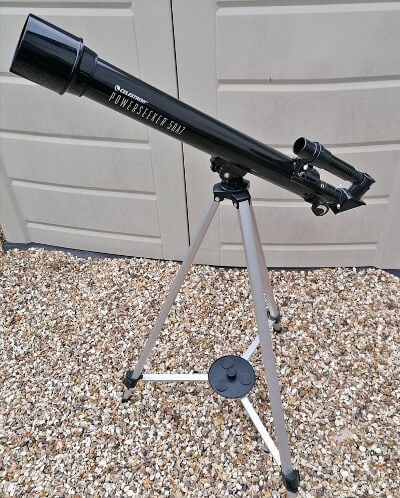
The advantages of a spotting scope over a telescope for astronomy are:
- Spotting scopes are lighter, more compact, and easier to handle.
- They are more portable and usually come with sturdy carry cases.
- They can be used both day and night on a regular tripod.
- They are usually more hardy and waterproof (astronomical telescopes are not usually waterproof as you’d never be using them under rain clouds).
- Because they are designed to be hardy, spotting scopes often come with a much longer warranty than astronomy telescopes.
- They are usually cheaper (but you do generally get what you pay for in terms of optics).
The disadvantages of spotting scopes in comparison to telescopes are:
- Regular spotting scopes typically have a straight-through or 45-degree angled eyepiece. This is optimized for terrestrial use, but not for looking up at the night sky. This is because for traditional spotting scope uses like bird watching you will be looking out close to the horizon and not tilted up. However, the Celestron spotting scope models recommended above can fit telescope diagonals to bypass this problem.
- Apart from the Celestron and Orion models above, the majority of regular spotting scopes have an in-built eyepiece that cannot be changed. For many spotting scopes this included eyepiece may not be that great for astronomy (unless you have a high-end model from Zeiss, Leica, or Swarovski where it should be pretty good).
Overall, spotting scopes are less tailored for astronomy than telescopes. But this is the trade-off for greater versatility.
For a more detailed overview of this, see our article on Spotting Scopes vs Telescopes.
One thing to note is that there is a middle ground if you value portability and ease of use with some great travel telescopes.
Spotting Scopes vs Monoculars for Astronomy
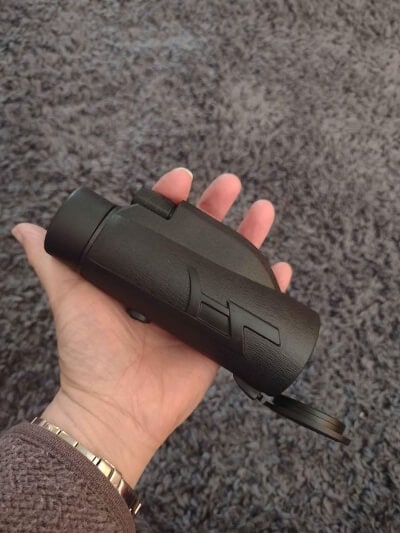
Another option to consider versus a spotting scope is a monocular.
Monoculars are effectively small handheld telescopes and so the advantages over a spotting scope are that they are even lighter and more compact – they can often just fit in your pocket. Plus they are cheaper.
The primary disadvantage will be that they will have lower aperture and be even less suited to astronomy and astrophotography and provide poorer quality views.
To read more on this, see Spotting Scopes vs Monoculars for Astronomy and the Best Monoculars for Stargazing & Astrophotography.
Spotting Scopes vs Binoculars for Astronomy
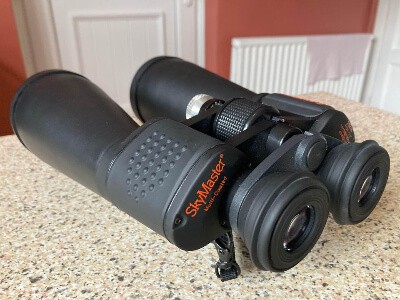
The advantages of spotting scopes over binoculars are that they are lighter and smaller. This is because they only have one tube with lenses, whereas binoculars have two. For the same reason, spotting scopes are usually cheaper than astronomy binoculars for the same quality optics.
The advantage of binoculars over spotting scopes is that they allow you to use both eyes when viewing, which is better for most (Note: you can get spotting scopes with dual eyepieces like the Orion model above).
Another advantage is that low-magnification binoculars can be used handheld for scanning the skies, whereas a spotting scope needs a tripod.
For more detail on this topic, see Spotting Scopes vs Binoculars for Astronomy: Which is Best?
To read more on binoculars, see the Best Astronomy Binoculars.
Astronomy Spotting Scope FAQs
What is a spotting scope?
A spotting scope is a compact telescope, generally optimized for daytime terrestrial purposes like bird watching, ocean viewing, shooting, etc.
See Spotting Scopes Wikipedia for more detail.
Can you use a spotting scope for astronomy?
Yes, you can use spotting scopes for astronomy. The models recommended in this article will work particularly well for night sky observing, as well as having versatility for daytime use.
There are some downsides to telescopes – which are optimized for night sky astronomy. But there are also upsides in terms of being smaller, lighter, hardier, and more portable, and you can use them for terrestrial purposes.
How to use a spotting scope for astronomy?
You would use a spotting scope for astronomy in much the same way you would a telescope: Attach it to a tripod and look up to the sky and locate objects using your favorite stargazing software or app (or just your eyes).
You may want to use a star diagonal for more comfortable viewing and, with the models recommended above, you can interchange the eyepieces for different astronomical telescope eyepieces and filters to get different views.
Can you use a spotting scope for astrophotography?
Yes, the Celestron C5 and C90 above can have DSLR or mirrorless cameras directly attached (often called “digiscoping”).
You will need to buy a separate T-Adapter and T-Ring for your model camera to do this. You will also need to make sure your tripod and mount can take the combined weight.
With other spotting scopes, you can take photos with your phone using a smartphone adapter.
What’s the best tripod for spotting scopes?
Spotting scopes can be used with regular camera tripods. The tripod will just need to hold the weight of the scope (possibly with a camera or smartphone attached).
See the Best Tripods for Astrophotography for more recommended models at different budgets.
Can I see Mars, Jupiter, or Saturn’s rings with a spotting scope?
Yes, good spotting scopes in the right conditions will allow you to see planets like Mars, Jupiter, and Saturn.
The higher the aperture of the spotting scope, the better the views will be.
Do spotting scopes accept astronomical eyepieces and filters?
Most regular spotting scopes do not allow interchangeable eyepieces, they have in-built eyepieces.
However, the Celestron models recommended in this article do allow you to interchange for astronomical eyepieces.
Verdict: Best Spotting Scope for Astronomy
Overall then, we recommend:
- The Celestron C5 if you want the most powerful spotting scope for astronomy.
- The Celestron C90 Mak is a great middle-ground of being able to provide great views but being smaller, lighter, and cheaper than the C5.
- The Celestron C70 Mini Mak is great if you want something ultra-portable and with a tripod included.


